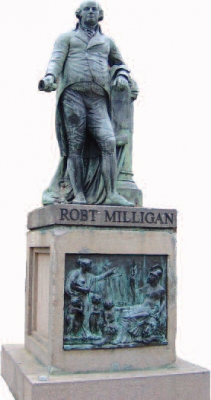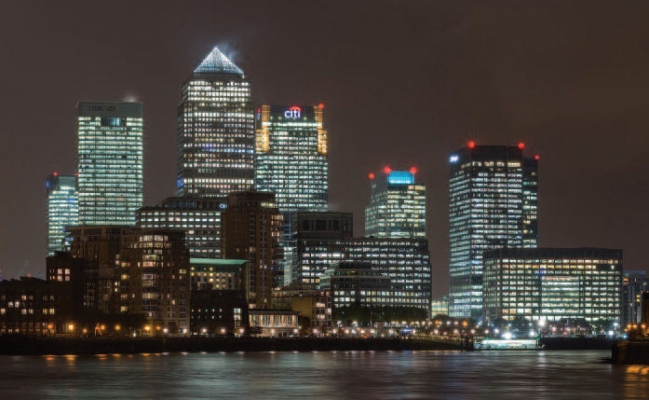Tunnel Vision
Recently, however, I did, and what a revelation it was - like entering another world, surrounded by massive skyscrapers and canals - totally unexpected. The experience when you eventually emerge into the daylight at the top of the Underground escalators is similar to arriving in Manhattan, so it was no surprise to learn that this area has some of the largest tower blocks in
Europe, including the second largest building in the UK, No. 1 Canada Square. Canary Wharf is one of the two main UK financial centres, the other being the traditional City of London. More than 105,000 people work at the European HQs of many international banks, finance, media and service companies – a melting pot of employees from many different countries.
Canary Wharf derives its name from berth 32 of the West Wood Quay, built in 1936 for the import of fruit from the Mediterranean and the Canary Isles. The area was once known as The Isle of Dogs. Diarist Samuel Pepys referred to it as "The Unlucky Isle of Dogs" as it was prone to flooding, and gibbets, for public executions, were regularly erected on the foreshore near Greenwich.
Its proximity to the Thames led to the creation of shipbuilding and diverse maritime industries. In 1802 the West India Docks opened for trade, reaching its peak in the mid-19th century.
The area was massively damaged by German bombing during WWII, followed by a brief period of prosperity in the 1950's, but between 1960 - 1980 all London's docks were closed largely because the shipping industry had moved to deep water ports elsewhere, more suitable for the development of containerisation. The area went into sharp decline.
All this changed, however, when London Docklands decided to develop the area. The company had ambitious plans and severe critics in the early days, particularly those in the City, probably concerned with maintaining their monopoly. Many dismissed the project as a white elephant and companies were reluctant to venture into 'the unknown' where they feared they might face
financial disaster. The logistics of getting there was a major problem, however the prophets of doom were proved wrong for, with the advent of the DLR (Docklands Light Railway), City Airport and the extension of the Jubilee line - the place is buzzing with activity.
My initial reason for visiting the area was to see the Museum of the Docklands. This opened in 2003 in a 19th century sugar warehouse. The museum is captivating and warrants a story of its own, though on this visit I was specifically attracted by their exhibition 'Tunnel - The Archaeology of Crossrail'.
Crossrail began constructing the new Elizabeth Line in 2009 – one of the largest engineering projects in Europe. Covering 118 kilometres from Shenfield in the east to Heathrow and Reading in the west, 42 kilometres of tunnels were excavated by eight massive circular drills – TunnelBoring Machines (TBM's). I smiled on discovering that, following mining tradition, each TBM is given a woman's name – for this project Victoria, Elizabeth, Jessica, Ellie, Sophia, Mary, Ada and Phyllis were employed.
I wondered why the female of the species should be selected for what is, quite evidently 'man's work'. Surely Arthur, Angus, Fergus, Gabriel, Gareth or Samson (names which denote strength) might have been more appropriate. However, it was only when learning that 'Ada', whilst tunnelling from Paddington to Farringdon, came within 90cms of live Northern Line platforms and 60cms away from passenger escalators, but nevertheless passed through safely, I realised that perhaps brute strength is not everything.
This tradition for female names dates to the 1500's when miners displayed statues of St Barbara underground to protect them from danger. The Barbara in question was a martyr who possibly lived in the 3rd century. Renowned for her beauty, she was locked in a tower by her father Dioscorus. Whilst there she secretly converted to Christianity. Her pagan father was so enraged
that he tortured her cruelly, finally beheading her himself for her 'transgression'. Instantaneously he was killed by a flash of lightning.
Barbara was accordingly attributed with supernatural powers, becoming the patron saint of all those working with explosives – armourers, geologists, and artillerymen, plus, for some inexplicable reason, mathematicians. Today she is honoured in many countries and is the patron of the Italian navy – despite the doubts surrounding her history. These led to her removal from the General Roman Calendar, but she remains on the list of Martyrs and Saints.
In addition to technicians, planners and surveyors, Crossrail employs 100 archaeologists. Their role is working alongside the engineers, where they have the unique opportunity of examining the layers of history exposed by the tunnelling. Over 10,000 artefacts covering millions of years of history have been discovered.
The oldest items were found in Canary Wharf whilst the dock was being drained including a fragment of amber estimated to be 55 million years old and a bone from the jaw of a woolly mammoth from the Ice Age. At North Woolwich evidence confirmed the presence of a Mesolithic encampment with remains of tools from 8,500 years ago.
Finds from the Roman period include coins dating from the conquest of Britain in AD 43 featuring Emperor Claudius, and everyday items of pots, tools and jewellery – including some in the form of phalluses, bringing good luck to the wearer.
Remains of a Roman cemetery revealed skeletons, some with the skull removed and placed between the legs. Subsequent layers uncovered mass graves, probably from the Great Plague of 1665 when almost a quarter of London's population died.
Amazingly archaeologists today can test for diseases, including the plague, and can also identify information on the diet, nutrition and stress of an individual and even where they came from - all from examining the teeth of the skeletons.
Other finds reflect the nature of industries in the area; 15th century shops which manufactured and sold bone and ivory items and later, 13,000 marmalade jars, mustard pots and glass stoppers were found in a pit from the Crosse and Blackwell pickle factory. This closed in 1921 when a journalist, grieving its departure, wrote "I can travel blindfold through London and recognise
certain places just by their smell. This factory added a very distinctive pungency to its surroundings".
Occasionally, noteworthy buildings had to be demolished to make way for Crossrail. The Astoria cinema and dance hall, later to become a venue for live concerts, was one such example. In all cases archaeologists kept scrupulously detailed records of each building, using laser scanning, surveying and photography as part of their work.
Overall I was fascinated to learn about the detailed logistical planning and the complexity that have gone into not just demolishing and reconstructing, but in protecting our heritage unearthed in the process.
The philosophy of sustainability is central to Crossrail. Historic building materials have been reused wherever possible and of the 7 million tonnes of earth excavated, 98% was used to create new farm or industrial land as well as nature reserves and recreational sites. Most of the TBM's were sold around the world, but parts of Ada and Phyllis had to be buried close to where they dug their last tunnel. Perhaps they will be a legacy for future archaeologists to discover long after we are gone.










Comments